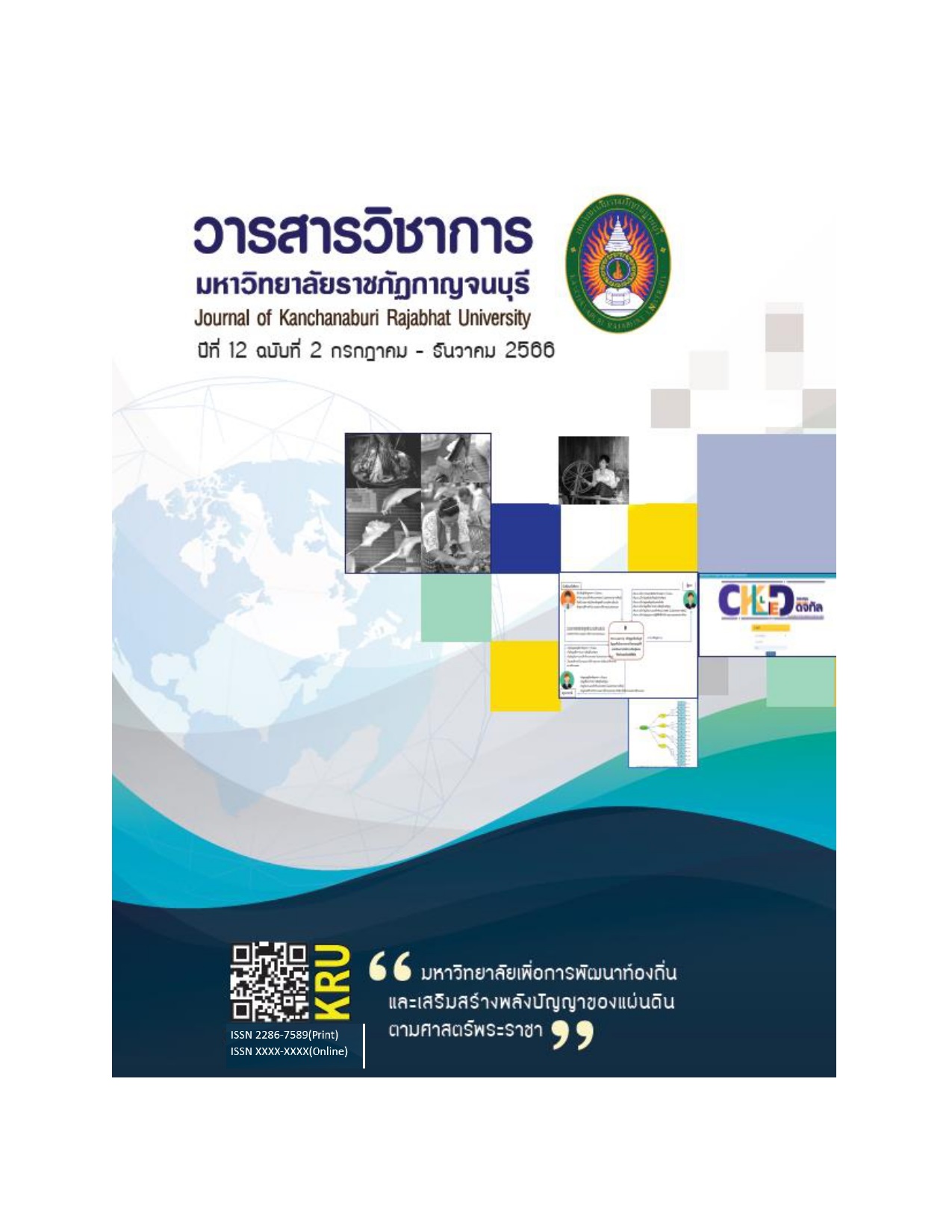ปัจจัยที่มีความสัมพันธ์กับความสุขในการทำงานของบุคลากรสังกัดองค์การบริหารส่วนจังหวัดกาญจนบุรี
Main Article Content
Abstract
The aim of this research was to study 1) personal, work and organizational commitment factors of personnel, 2 ) level of happiness at work of personnel, and 3 ) the relationship between personal, work, and organizational commitment factors of personnel, and happiness at work among personnel, all at the Kanchanaburi Provincial Administrative Organization (PAO).
This cross-sectional analytical research. All population of Kanchanaburi PAO is 449 people. The sample group was obtained from multiple regression analysis of 403 people and another 10% of the sample was added. Therefore, a total of 443 were studied people. Data were collected using a questionnaire with the reliability value of 0.94, and statistically analyzed using frequency, percentage, mean, standard deviation and stepwise multiple regression analysis.
The results revealed that, among all the 443 PAO personnel (respondents): 1) most of them were married women aged 41–50 years, had 1–3 children, had obtained an associate’s or bachelor’s degree, had been working as government officials, teachers or employees of the PAO for 15 years or more, and had a monthly income of 15,000–29,999 baht; 2) the level of their happiness at work, on a 0–100 scale. was 72.9 + 5.5 (mean + SD); and 3) the significant relationships (regression coefficient, or B, on a 1–5 scale; p-value < 0.05) between happiness at work and various factors were: personal factors including female gender (B: 1.7, 95%CI: 1.1–2.2), postgraduate education (B: 0.8, 95%CI: 0.0–1.5), being employed for specific or general mission (B: -1.3, 95%CI: (-2.3)–(-0.4)), monthly income of 15,000–29,999 baht (B: 0.9, 95%CI: 0.1–1.7), and monthly income of 30,000 baht or more (B: 1.7, 95%CI: 0.6–2.8); work-related factors including relationship at work (B: 3.3, 95%CI: 2.7–3.9), welfare and compensation (B: 2.1, 95%CI: 1.2–3.0) and work environment (B: 1.7, 95%CI: 1.1–2.4); and organizational commitment factors including feelings (B: 2.4, 95%CI: 1.7–3.1) and persistency (B: 0.8, 95%CI: 0.2–1.5), all of which could 73.5% (R2 = 0.735) predict their happiness at work at the Kanchanaburi PAO. Thus, agency executives
should attach the importance to the development of personnel relationships in coexistence, including honoring and giving personnel the opportunity to develop creative thinking, creating a pleasant working environment that will make the personnel happy to work and desire to continue working with the organization.
Article Details

This work is licensed under a Creative Commons Attribution-NonCommercial-NoDerivatives 4.0 International License.
References
กฤษดา แสวงดี. (2554). ประมวลหลักปฏิบัติองค์การอนามัยโลกว่าด้วยการสรรหาบุคลากรด้านสุขภาพเข้าทำงานระหว่างประเทศ. กรุงเทพฯ: เดอะกราฟิโก ซิสเต็มส์.
กัญจน์ภัส ชูผล. (2559). ความผูกพันต่อองค์การ คุณภาพชีวิตการทำงาน และความพึงพอใจในการปฏิบัติงานของพนักงานขายแห่งหนึ่งในจังหวัดสมุทรปราการ. ปริญญาบริหารธุรกิจมหาบัณฑิต วิทยาลัยนวัตกรรมการจัดการ มหาวิทยาลัยเทคโนโลยีราชมงคลรัตนโกสินทร์.
กานต์ชนก แซ่อุ่ย. (2554). ปัจจัยพยากรณ์ภาวะหมดไฟในการทางานของผู้ให้การปรึกษาในเขตภาคเหนือตอนบนของประเทศไทย. วิทยานิพนธ์วิทยาศาสตรมหาบัณฑิต (จิตวิทยาการปรึกษา) บัณฑิตวิทยาลัยมหาวิทยาลัยเชียงใหม่.
ขวัญลดา สุรินทร์. (2556). ความสุขในการทำงานของพนักงานองค์กรปกครองส่วนท้องถิ่นในอาเภอเวียงแก่น จังหวัดเชียงราย. การศึกษาค้นคว้าอิสระบริหารธุรกิจมหาบัณฑิต มหาวิทยาลัยแม่ฟ้าหลวง.
ชุติมณฑ์ ฟ้าภิญโญ. (2553). ความสุขในการทางานให้กับบริษัทควอลิตี้เซรามิกจากัด ลำปาง. การศึกษาค้นคว้าอิสระบริหารธุรกิจมหาบัณฑิต บัณฑิตวิทยาลัย มหาวิทยาลัยเชียงใหม่.
ณัฐนันท์ ฤทธิ์สาเร็จ. (2563). ปัจจัยที่มีความสัมพันธ์กับภาวะหมดไฟในการทำงานของบุคลากรในโรงพยาบาลเอกชน อาเภอเมืองชลบุรี จังหวัดชลบุรี. วารสารสาธารณสุขมหาวิทยาลัยบูรพา, 17(1), 86 – 99.
ธิดารักษ์ ลือชา และกฤษฎากรณ์ ยูงทอง. (2560). ความสุขในการทางาน : ความหมายและการวัด. วารสารราชภัฎเพชรบูรณ์สาร, 19(2), 9 – 18.
นฤมล แสวงผล. (2554). ปัจจัยที่มีผลต่อความสุขในการทำงานของบุคลากรคณะบริหารธุรกิจ มหาวิทยาลัยเทคโนโลยีราชมงคลธัญบุรี. การศึกษาค้นคว้าอิสระบริหารธุรกิจมหาบัณฑิต สาขาการจัดการทั่วไป คณะบริหารธุรกิจ มหาวิทยาลัยเทคโนโลยีราชมงคลธัญบุรี.
โพสต์ทูเดย์. (2563). BURNOUT IN THE CITY งานวิจัยชี้ชาวกรุงวัยทำงานเกินครึ่งเสี่ยงหมดไฟ. ค้นเมื่อ มีนาคม 21, 2566, จาก https://www.posttoday.com/lifestyle/613654.
วิภาดา แก้วนิยมชัยศรี. (2556). ปัจจัยที่มีผลต่อการเป็นองค์กรแห่งความสุขของเทศบาลในจังหวัดบึงกาฬ. วิทยานิพนธ์รัฐประศาสนศาสตรมหาบัณฑิต สาขารัฐประศาสนศาสตร์ บัณฑิตวิทยาลัย มหาวิทยาลัยศิลปากร.
ศิรินธร สายสุนทร. (2558). ความสุขในการทำงานของพนักงานบริษัทแกล็กโซสมิทไคล์น (ประเทศไทย) จำกัด. วารสารครุศาสตร์อุตสาหกรรม, 14(3), 431 – 437.
ศิรินันท์ กิตติสุขสถิต กาญจนา ตั้งชลทิพย์ สุภรต์ จรัสสิทธิ์ เฉลิมพล สายประเสริฐ พอตา บุนยตีรณะ และวรรณภา อารีย์. (2555). คู่มือการวัดความสุขด้วยตนเอง Happinometer. กรุงเทพฯ: ธรรมดาเพรส.
ศุภวัฒน์ วิรักขะโม. (2553). ความสุขในการทำงานของเจ้าหน้าที่ในเทศบาลตำบลหนองเบน อำเภอเมือง จังหวัดนครสวรรค์. วิทยานิพนธ์รัฐประศาสนศาสตรมหาบัณฑิต สาขารัฐประศาสนศาสตร์ คณะมนุษยศาสตร์และสังคมศาสตร์ มหาวิทยาลัยขอนแก่น.
สุวีณา ไชยแสนย์. (2559). องค์กรแห่งความสุขขององค์การบริหารส่วนตำบลในเขตอำเภอแกดา จังหวัดมหาสารคาม. วารสารการเมืองการปกครอง, 6(1), 167 – 183.
อภิชาติ ภู่พานิช. (2551). การใช้ดัชนีวัดระดับความสุขในการทำงานของบุคลากรสังกัดสานักงานอธิการบดีมหาวิทยาลัยธรรมศาสตร์. วิทยานิพนธ์สังคมสงเคราะห์ศาสตร คณะสังคมสงเคราะห์ศาสตร์ มหาวิทยาลัยธรรมศาสตร์.
Maslow, Abraham H. (1970). Motivation and Personality 2nd. New York: Harper & Row. Newstrom, J.W. and Davis, K. (2002). Organizational behavior: Human behavior at work. New York: McGraw-Hill.


